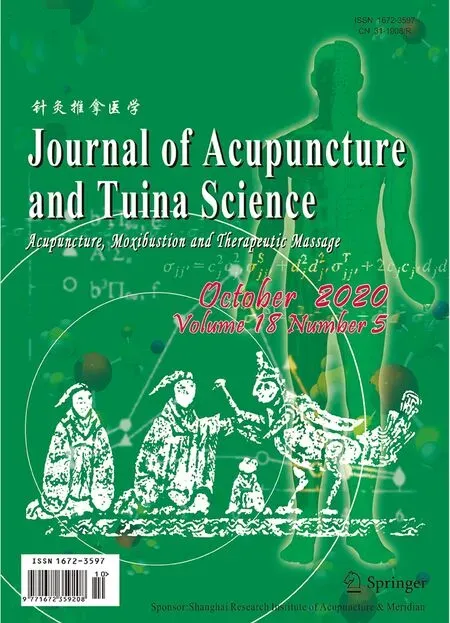Clinical observation on electroacupuncture plus Yi Jin Jing (Sinew-transform ing Qigong Exercises) for knee osteoarthritis
2020-10-23DingJiayan丁佳燕JuZiyong具紫勇ZhuYijun祝义军JiangXu蒋旭WangYuehua王月花CuiHuashun崔花顺
Ding Jia-yan (丁佳燕),Ju Zi-yong (具紫勇),Zhu Yi-jun (祝义军),Jiang Xu (蒋旭),Wang Yue-hua (王月花),Cui Hua-shun (崔花顺)
1Shuguang Hospital,Shanghai University of Traditional ChineseMedicine,Shanghai201203,China
2Renji Hospital A ffiliated to Shanghai Jiaotong University School of Medicine,Shanghai201112,China
3 ShanghaiUniversity of Traditional Chinese Medicine,Shanghai 201203,China
4 Jiading Central Hospital ShanghaiUniversity of Medicine &Health Science,Shanghai201899,China
5Community Health Service Center of Yuyuan Street,Huangpu District,Shanghai,Shanghai200010,China
Abstract
Keywords:Acupuncture Therapy; Electroacupuncture; Yi Jin Jing; Physical and Breathing Exercises;Exercise; Visual Analog Scale; Pain Measurement;Osteoarthritis, Knee
Knee osteoarthritis(KOA),a degenerative joint disease, is mostly found in the m iddle-aged and elderly people, w ith the main symptoms of knee joint pain,stiffness and lim ited movement. Pathological changes mostly are articular cartilage injury, osteophyte formation and soft tissue changes[1]. With the global aggravation of the aging process, the incidence rate of KOA is increasing year by year. Statistics show that the prevalence rate of KOA in China is 18%,and the prevalence rate in women is significantly higher than that in men[2].
The clinical treatment of KOA now emphasizes the control of disease progression and symptoms relieving.Western medicine mainly uses nonsteroidal antiinflammatory drugs to reduce articular cartilage inflammation and pain, but the effect in preventing and delaying the pathological development of KOA is lim ited.Moreover, there are obvious adverse reactions given longtime use of the Western medicine, along w ith a high price. Study shows that acupuncture treatment can relieve KOA patients' joint pain and stiffness, promote joint function recovery, and produce more significant clinical efficacy than Western medicine[3].The international KOA treatment guidelines give priority to exercise therapy such as quadriceps femoris exercise,aerobic exercise and movements exercise[4]. Yi Jin Jing (Sinew-transform ing Qigong Exercises)is a kind of physical and breathing exercises (Daoyin) to strengthen the tendons and bones[5]. In recent years, we studied the efficay of electroacupuncture (EA) plus Yi Jin Jing (Sinew-transform ing Qigong Exercises)for KOA.The details are as follows.
1Clinical Materials
1.1 Diagnostic criteria
The diagnostic criteria referred the criteria for KOA described by the American College of Rheumatology (ACR)in 1995[6],and Kellgren classification[7].① Frequent knee pain in one month;② crepitus on knee motion; ③ morning stiffness less than 30 m in;④ aged 38 years old or older; ⑤ knee exam ination revealed bone hypertrophy. Those who met the above①+②+③+④or ①+②+⑤or ①+④+⑤could be diagnosed w ith KOA.
Disease classification standard of KOA X-ray examination referred Kellgren classification. Grade 0: no radiological findings of osteoarthritis;gradeⅠ:potential narrow ing of joint space and osteophytic lipping;gradeⅡ:definite osteophytes and possible narrowing of joint space;grade Ⅲ:significant osteophytes,definite narrow ing of joint space,and subchondral bone sclerosis; gradeⅣ: large amount of osteophytes,severe narrow ing of joint space,subchondral bone sclerosis bone cyst and joint deformity.
1.2 Inclusion criteria
Those who met the above diagnostic criteria; aged 38-70 years old; able to complete Yi Jin Jing (Sinewtransform ing Qigong Exercises); voluntary participation in this study and signed informed consent.
1.3 Exclusion criteria
Those who were receiving other treatments which might interfere the result evaluation of this study; those w ith obvious varus or valgus deform ity of knee joint or history of vascular and nerve injuries of the affected limb; women who were during pregnancy or lactation period.
1.4 Statistical methods

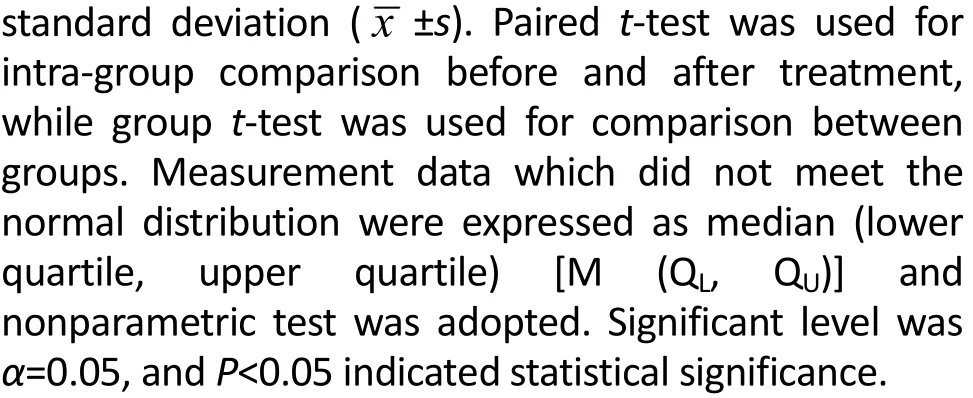
1.5 General data
A total of 60 cases w ith KOA who received treatment from the Acupuncture Department of Shuguang Hospital,Shanghai University of Traditional Chinese Medicine between August 2017 and January 2019 were recruited in the study. They were random ly divided into a control group and an observation group, with 30 cases in each group.Four cases in the observation group dropped out during treatment.There were no significant between-group differences in gender,age and disease duration,indicating that the two groups were comparable (Table 1).

Table 1.Com parison of general data between the two groups
2 Therapeutic Methods
2.1 Control group
Patients in the control group received EA treatment.
Major points: Yanglingquan (GB 34), Liangqiu (ST 34),Zusanli (ST 36), Neixiyan (EX-LE 4) and Dubi (ST 35) on the affected side.
Adjunct points based on pattern differentiation:Xuanzhong (GB 39) for kidney and marrow deficiency;Yinlingquan (SP 9) for cold and dampness obstruction;Xuehai (SP 10) for blood stasis; Guanyuan (CV 4) for spleen and kidney deficiency; Sanyinjiao (SP 6) for yin deficiency of liver and kidney;Quchi(LI 11)for dampness and heat obstruction.
Methods:The patient took a supine position. Filiform needles of 0.25 mm in diameter and 40 mm in length were adopted.Single-handed insertion was used.Needling-direction reducing manipulation was adopted for excess patterns, that was, obliquely inserting the needle against the running direction of meridian into 1.2-1.5 cun. Needling-direction reinforcing method was for deficiency patterns, that was, obliquely inserting the needle along the running direction of meridian into 1.2-1.5 cun.EA was adopted after needling qi was obtained. The negative electrode was connected to the handle of the needle inserted at Yanglingquan (GB 34),and the positive onewas connected to that at Liangqiu(ST 34). Continuous wave was used w ith frequency of 2 Hz and current intensity of 0.5-1.5 mA. The needles were retained for 20 m in each time, and the treatment was performed tw ice a week for 5 weeks.
2.2 Observation group
2.2.1 EA treatment
Patients in the observation group were given the same EA treatment as in the control group, including the same points, methods, EA parameters as well as the treatment course.
2.2.2 Yi Jin Jing (Sinew-transform ing Qigong Exercises)
Part one:Preparation,including the movement of each body joint, for about 5 m in.
Part two:Several parts of Yi Jin Jing (Sinewtransform ing Qigong Exercises),including the movements of dragging nine oxen by their tails and wagging the tail. The details shall be subject to the official version released by the Qigong Management Center of General Adm inistration of Sport of China[8].Dragging nine oxen by their tails (Figure 1).① Bended the knees slightly and moved the body's gravity to the right. Moved the right foot one step rightward to form a right bow step. At the same time, the left hand rotated inward, stretching forward and downward in an arc with the left hand clenched and palm upward. The right hand moved forward and upward in an arc. Clenched the right hand when it arrived at the same level of shoulder, w ith palm upward and lightly higher than the shoulder; focused the sight on the right fist. ② Bended the knees slightly and moved the body's gravity backward; turned the waist slightly to the right, w ith the right arm outward while the left arm inward, and the elbow inward;eyes focused on the right fist.③ Moved the body's gravity forward and bended the knees slightly to form a bow step. Turned the waist slightly to the left,relaxed the arms and stretched forward and backward; the eyes focused on the right fist. ④ Moved the body's gravity forward to the right foot, took back the left foot, turned the toes of the right foot forward, w ith feet separated slightly wider than the shoulders. Placed the arms naturally on two sides of the body; the eyes focused lower forward. The movements of the left side were same as those of the right side,only in opposite directions. Wagging the tail (Figure 2 and Figure 3). Stood w ith separated feet, slightly wider than the shoulders.Stretched the arms naturally forward, w ith fingers crossed and holding each other,and palms inward. Bended the elbows and turned the palms outward;bended the elbows and turned the palms to the lower part of the chest; bended the body forward and raised the head, w ith the two hands slow ly crossed and pressing downward;the eyes focused forward.① Turned the head to the left and back, and at the same time,turned the hips to the left and forward;the eyes focused on Changqiang(GV 1).② Kept the hands crossed and the body relaxed to reach forward. ③ Turned the head to the right and back, and at the same time, turned the hips to the right and front;the eyes focused on Changqiang(GV 1).④ Kept the hands crossed and the body relaxed to reach forward.Practiced each movement twice for about 15 m in.
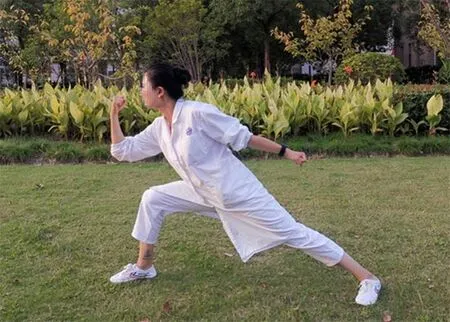
Figure 1. Dragging nine oxen by their tails
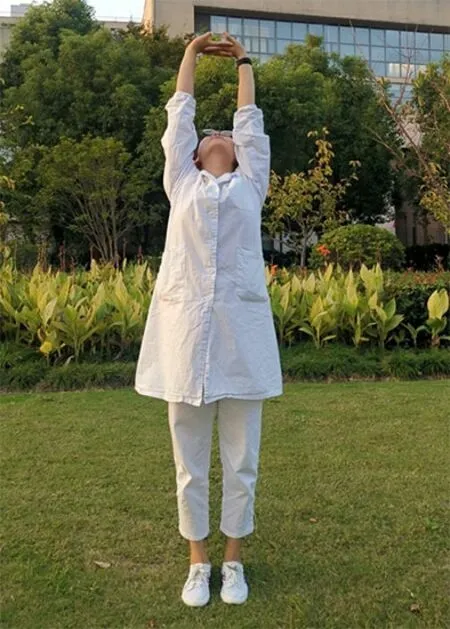
Figure 2. Starting posture of wagging the tail

Figure 3. Wagging the tail
Part three:Zhan Zhuang (standing pose).The movement of Hun Yuan standing pose was selected(Figure 4).The details shall be subject to the requirements of Hun Yuan standing pose in Chinese traditional Wu Shu(martial arts).Stood with feet shoulder-width apart, with the knees bended slightly.The patella and the toes were in a vertical line. Lifted up the anus and sit downward. Raised the arms and placed them in front of the chest in an oval shape. The two hands were about 30 cm away from each other. Relaxed the neck muscles, raised the head, gently closed the eyes and the mouth with the tongue against the palate,and breathed naturally via the nose.Every time the practice was finished until soreness and heaviness of the thighs (about 5-10 m in).

Figure 4. Hunyuan standing pose
The patients were given on-site guidance during the first visit to the hospital,and were sent the exercise videos and documents.The exercises were guaranteed by WeChat supervision.During this study,patients were required to carry out the above exercises in a quiet and com fortable environment,three times a week for 5 weeks.
3 Observation of Clinical Efficacy
3.1 Observed items
3.1.1 Western Ontario and McMaster Universities Osteoarthritis index (WOMAC)
WOMAC was used to evaluate pain,stiffness and joint function in KOA patients before and after treatment. Each item was scored 0-10 points, and the higher the score,the more serious the patient's condition.
3.1.2 Visual analog scale (VAS)
The VAS score was 0-10 points.It was used to evaluate the pain degree before and after treatment.The higher the score, the more intensive the pain.
3.2 Efficacy evaluation criteria
According to theCriteria of Diagnosis and Therapeutic Effects of Diseases and Syndromes in Traditional Chinese Medicine[9]and relevant literature[10],the clinical efficacy criteria of this study were formulated. The efficacy was evaluated after treatment.
Recovery: The clinical symptoms disappeared, knee joint function returned to normal,and imaging exam ination results were normal.
Markedly effective:The main clinical symptoms disappeared,the joint motor function basically recovered, normal work and labor could be carried out,and the main clinical objective detection indexes returned to normal.
Effective:The main clinical symptoms basically disappeared,the joint function was significantly improved, the ability of self-care or work was restored,and the main clinical objective detection indexes were improved.
Failure: The clinical symptoms did not disappear, and the joint dysfunction did not improve or even worsened.
3.3 Results
3.3.1 Comparison of the clinical efficacy
The total effective rate was 92.3% in the observation group and 70.0% in the control group,show ing a significant difference (P<0.05), (Table 2).

Table 2. Comparison of the efficacy between the two groups (case)
3.3.2 Comparison of the WOMAC score
Before treatment, there were no significant between- group differences in the pain,stiffness,motor dysfunction and WOMAC total scores (allP>0.05). After treatment, the pain, stiffness, motor dysfunction and WOMAC total scores in the two groups were significantly lower than those before treatment(allP<0.01);there were significant between-group differences in the post-treatment changes in the pain,stiffness, motor dysfunction and WOMAC total scores(P<0.05 orP<0.01). These results suggested that the symptoms of patients in both groups improved after treatment, and the improvements in the observation group were more significant than those in the control group. Please check Table 3 for details.3.3.3 Comparison of the VAS score
Before treatment, there was no significant betweengroup difference in the VAS score(P>0.05).After treatment, the VAS scores were significantly decreased in both groups (bothP<0.01). There was a significant between-group difference in the post-treatment change of the VAS score (P<0.01). These results suggested that the pain of patients in both groups was relieved after treatment,and the improvement in the observation group was more significant than that in the control group. Please check Table 4 for details.
Table 3.Com parisons of the WOMAC scores between the two groupsbefore and after treatment (±s, point)

Table 3.Com parisons of the WOMAC scores between the two groupsbefore and after treatment (±s, point)
Note:Compared with that before treatment in the same group,1) P<0.01;compared w ith the control group, 2) P<0.05,3) P<0.01
Observation group(n=26)Control group(n=30)Item Before treatment A fter treatment Post-treatment change Before treatment After treatment Post-treatment change Pain 16.96±6.78 10.46±6.511) 6.50±2.212)17.87±5.42 12.87±4.171) 5.00±2.69 Stiffness 4.11±1.75 1.88±1.401) 2.23±0.912)4.90±1.67 3.07±1.341) 1.83±0.99 Dysfunction 47.88±20.23 23.12±14.381) 24.77±9.523)61.07±16.25 43.63±14.161)17.43±8.22 Total score 68.96±25.08 35.46±18.161) 33.50±11.083)83.83±22.38 59.57±19.181)24.27±9.99
Table 4. Comparison of the VASscore between the two groups (±s, point)

Table 4. Comparison of the VASscore between the two groups (±s, point)
Note:Compared with that before treatment in the same group,1) P<0.01;compared with the control group, 2) P<0.05
Group n Before treatment A fter treatment Post-treatment change Observation 26 6.46±1.39 3.35±1.231)3.12±1.212) Control 30 5.50±1.04 3.20±1.031)2.30±0.84
4 Discussion
KOA is mainly attributed to deficiency of healthy qi,pathogenic w ind,cold and dampness blocking meridians and collaterals, and obstruction of phlegm and stagnation. According to its etiology, pathogenesis and clinical symptoms, it falls under the category of Gu Bi(bone Bi-impediment syndrome)in traditional Chinese medicine.Western medicine holds that the onset of KOA is as associated with gender, age, living environment, body weight and joint injury. It usually has a long disease duration and high disability rate[11-13]. The treatment of KOA is still mainly to relieve clinical symptoms and delay the progression of joint structure degeneration and dysfunction, and there is no specific treatment.
This study observed the efficacy of EA plus Yi Jin Jing (Sinew-transform ing Qigong Exercises)exercise in treating KOA. Clinical research showed that EA therapy can stimulate the peripheral nervous system by continuously exciting the acupoints around the knee joint to relieve pain,and improve and promote the recovery of the function of the damaged knee joint lesions,with the advantages of quick and valid long-term effect and high safety. The research on the mechanism of EA treatment of KOA is also deepening[14-16].At present,exercise therapy,w ith valid clinicalefficacy,isgiven priority in the globalguidelines for KOA treatmentand recognized by many orthopaedic surgeons.Yi Jin Jing (Sinew-transform ing Qigong Exercises)is a unique traditional Chinese health preservation exercise.It has integrated the Wu Qin Xi(Five-animal Exercises),theory of meridians and collaterals,and Confucianism.Long-term practice w ill benefit human respiratory system, circulatory system,motor system,immune system andmentalhealth[17-19].It can effectively improve the stability of knee joint,improve the muscle strength of lower-limb extensor muscle group,and enhance the muscle strength and motor function of both extensor and flexor muscle groups,thus delaying the degeneration of skeletal muscles in the elderly[20-21].Themovementsof dragging nine oxen by their tails and wagging the tail were adopted in this study. Dragging nine oxen by their tails can unblock themuscle regionsof Stomach Meridian to relieve the symptom of weakness and lassitude,and promote the transportation and transformation function of spleen.Wagging the tail,fully exercising the Governor Vessel and Liver Meridian,functions as strengthening the low back and legs through the traction,flexion and extension of the head,neck,chest,waist and hips.These two movements have strong effects inmaintaining the stability of the knee joint and improving its motor function.The practice of Zhan Zhuang (standing pose)is evolved from the traditional Chinese Wu Shu (martialarts). It is an integralexercise that makes the body, m ind,qiand strength contact and also restrict each other,thus keeping the balance of yin and yang.At present,it isamong the preferred exercise therapies for KOA because it can effectively improve the symptoms of knee joint lesions, enhance the function of knee joint, and improve the muscle strength of knee extensors[22].However,standing pose exercise alone cannot comprehensively improve the muscle strength around the knee joint[23].Therefore,this study integrated it w ith Yi Jin Jing (Sinew-transform ing Qigong Exercises) to further improve the stability and function of the knee joint.
Exercise therapy needs to be carried out regularly.The time for this study was lim ited,the treatment course was short, and a long-term follow-up was not carried out, which will be improved in future studies.
The results of this study showed that after 5 weeks of treatment,the improvements of WOMAC and VAS scores in the observation group were more significant than those in the control group, and the total effective rate was higher than that in the control group. This showed that EA plus Yi Jin Jing (Sinew-transform ing Qigong Exercises) was more effective in treating KOA.Compared w ith EA treatment alone, it can significantly relieve the clinical symptoms in the patients and restore knee joint motor function,thus worthy of clinical promotion.At the same time,by introducing the therapeutic effect of exercise therapy to patients and guiding patients to practice Yi Jin Jing (Sinew- transform ing Qigong Exercises), patients' understanding towards KOA treated by exercise therapy has been enhanced, which is another achievement of this study.
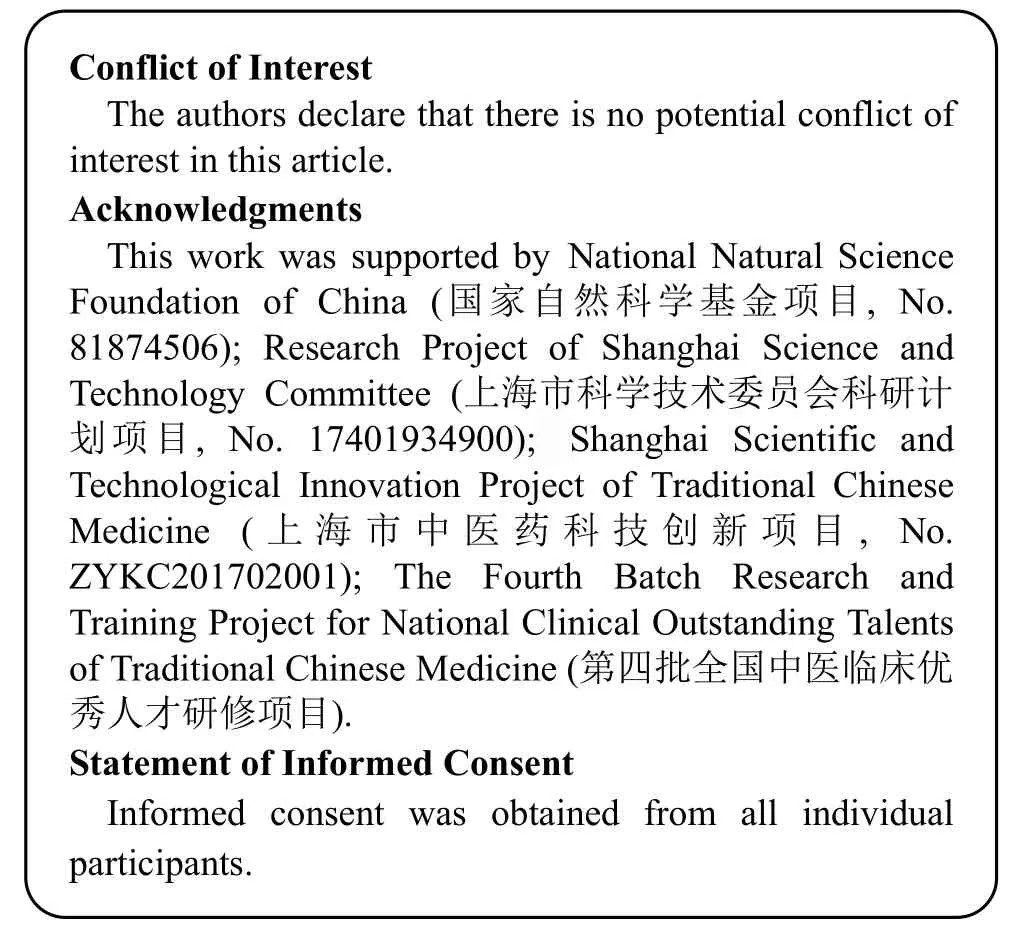
Conflict of Interest The authors declare that there is no potential conflict of interest in this article.Acknow ledgments This work was supported by National Natural Science Foundation of China (国家自然科学基金项目,No.81874506);Research Project of Shanghai Science and Technology Committee (上海市科学技术委员会科研计 划项目,No.17401934900); Shanghai Scientific and Technological Innovation Project of Traditional Chinese Medicine (上海市中医药科技创新项目,No.ZYKC201702001);The Fourth Batch Research and Training Project for National Clinical Outstanding Talents of Traditional ChineseMedicine (第四批全国中医临床优秀人才研修项目).Statement of Informed Consent Informed consent was obtained from all individual participants.
Received:22 January 2020/Accepted:20 February 2020
猜你喜欢
杂志排行
Journal of Acupuncture and Tuina Science的其它文章
- Clinical efficacy comparison of moxibustion w ith different doses for knee osteoarthritis
- Clinical observation of acupuncture and traction plus Ba Duan Jin (Eight-brocade Exercise) for improving discogenic low back pain
- Clinical observation on acupoint injection for back pain in patients w ith primary osteoporosis
- Clinical observation on Yi Jin Jing(Sinew-transform ing Qigong Exercises) plus tuina on the neck for stiff neck
- Efficacy evaluation of acupuncture plus rehabilitation training for post-stroke deglutition disorders of qi-deficiency blood stasis pattern
- Clinical observation of acupuncture plus Frenkel exercises for ataxia after cerebral stroke
